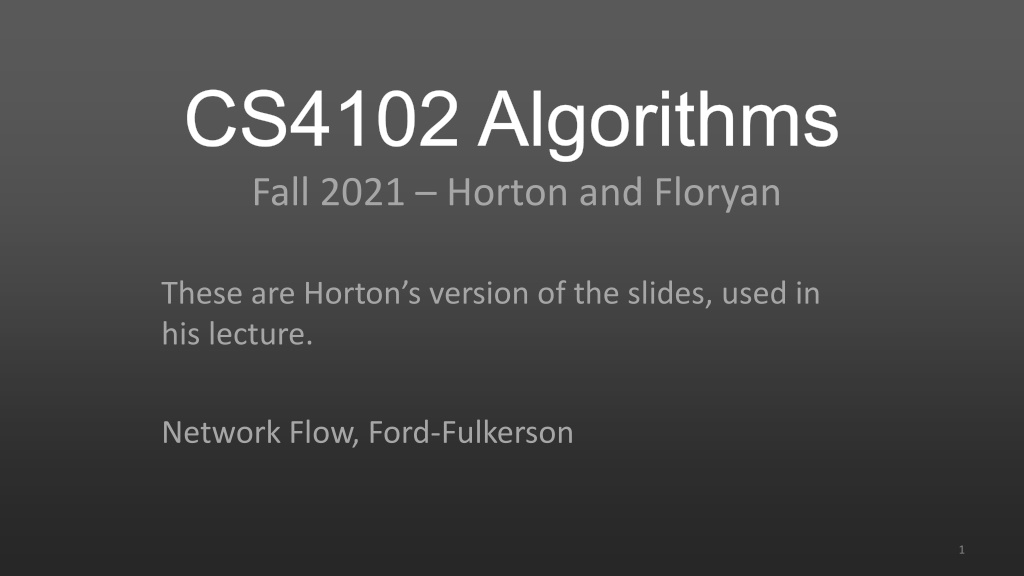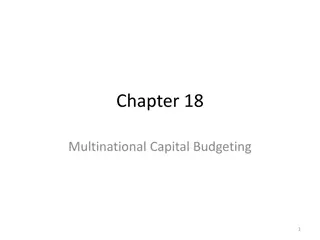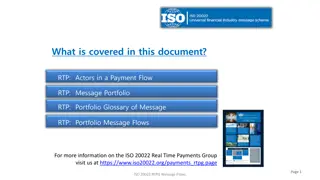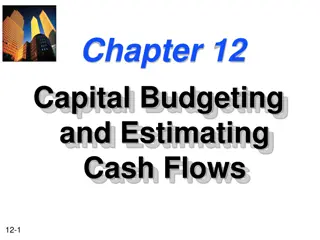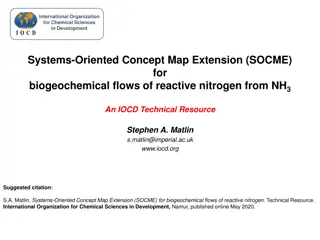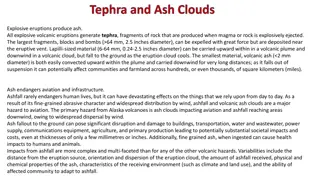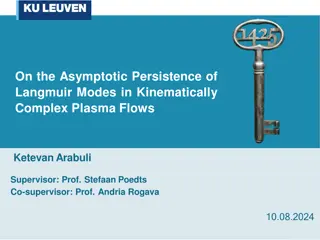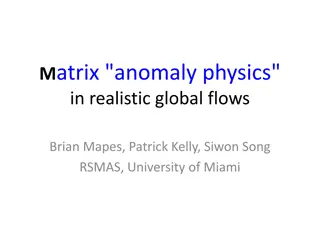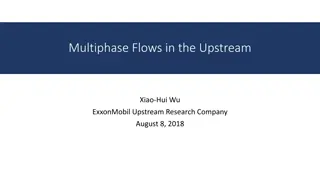Understanding Network Flows and Applications
Explore the concepts of network flows, including Ford-Fulkerson, maximum flow calculations, and handling complications like antiparallel edges. Learn about flow networks in various applications such as transportation and computer networks. Discover methods for adjusting flow graphs and assigning values to edges in a flow network.
Download Presentation

Please find below an Image/Link to download the presentation.
The content on the website is provided AS IS for your information and personal use only. It may not be sold, licensed, or shared on other websites without obtaining consent from the author. Download presentation by click this link. If you encounter any issues during the download, it is possible that the publisher has removed the file from their server.
E N D
Presentation Transcript
CS4102 Algorithms Fall 2021 Horton and Floryan These are Horton s version of the slides, used in his lecture. Network Flow, Ford-Fulkerson 1
In your textbook CLRS 26.1 and 26.2 Includes simple solutions to the following complications What if (u,v) and (v,u) are in the flow graph? Called Antiparallel edges easy to adjust for this, example later What if we need >1 source? >1 sink? 2
Flow networks Consider a flow network, which is a specialized directed graph with: A single source node s A single terminus node t Capacities on each edge That must be integer! What is the maximum flow you can send from s to t? 3
Applications Transportation networks How many people can be routed? Computer networks Electrical distribution Water distribution Note that all these applications have multiple sources and multiple sinks! Whereas the flow networks we study do not, yet 4
Flow Network 2 3 3 ? Graph ? = (?,?) Source node ? ? Sink node ? ? Edge Capacities ? ? Positive whole* numbers If ?,? ? then ?,? ? (Note our example here violates this!) ? 3 2 1 2 3 2 3 Max flow intuition: If ? is a faucet, ? is a drain, and ? connects to ? through a network of pipes with given capacities, what is the maximum amount of water which can flow from the faucet to the drain? 5
Flow Network: Antiparallel Edges Easy adjustment to remove antiparallel edges and have equivalent flow graph: add intermediate node 2 2 3 3 3 3 ? 2 ? ? 3 ? 3 2 1 2 3 1 2 3 2 2 2 3 3 (Note: our later examples use graph on the left without this adjustment.) 6
Flow 2/2 1/3 2/3 Assignment of values to edges ? ? = ? E.g. ? units of water going through that pipe Capacity constraint ? ? ?(?) Flow cannot exceed capacity Flow constraint ? ? {?,?}, ?????? ? = ???????(?) ?????? ? = ? ??(?,?) ??????? ? = ? ??(?,?) Water going in must match water coming out Flow of ?: |?| = ??????? ? ??????(?) Net outflow of ? ? 1/1 1/3 ? 2/2 1/2 2/3 1/2 2/3 Flow/Capacity 3 in example above 7
Lets Make Some Rules Source node has NO incoming flow Terminal (sink) node has NO outgoing flow Internal nodes has net zero flow all units of flow going in must be going out as well No edge is over capacity GOAL: Find the maximum flow that can be pushed through the network I.e. maximize: ? = ??????? ? ??????(?) 8
How to Solve This? This Greedy doesnt work Saturate Highest Capacity Path First 20 10 ? 30 ? 20 10 9
Greedy doesnt work Saturate Highest Capacity Path First 20 10 ? 30 ? 20 10 10
Greedy doesnt work Saturate Highest Capacity Path First 20/20 0/10 ? 20/30 ? 20/20 0/10 Overall Flow: ? = 20 11
Greedy doesnt work Better Solution 20/20 10/10 ? 10/30 ? 20/20 10/10 Overall Flow: ? = 30 12
Ford-Fulkerson: Algorithm overview Iterative algorithm: push some flow along some path at each step Model or record the residual capacities how much capacity is left after taking into account how much flow is going through that edge at this time Find a path from s to t such that the minimum residual capacity of an edge on that path is greater than zero Since each value is an integer, it must be 1 or more Update the residual capacities after taking into account this new flow Repeat until no more such paths are found 14
Algorithm notation f(u,v): the flow on the edge from u to v f(v,u): the backflow on the edge from v to u c(u,v): the capacity on the edge from u to v cf(u,v): the residual capacity on the edge from u to v Gf is the graph where the edges weights are the residual capacities THIS is usually the graph we actually use when running the algorithm we are about to see. 15
Backflow Each edge has forward flow and backflow The two must always be inverses of each other! I.e. they sum to the total capacity for that edge This allows for modeling of flow returning along a given edge One way to think about this: How much of the forward flow we could un-do 16
Residual Graph ?? Keep track of net available flow along each edge Forward edges : weight is equal to available flow along that edge in the flow graph o ? ? = ? ? ?(?) Back edges : weight is equal to backflow along that edge in the flow graph o ? ? = ?(?) Flow I could add Flow I could remove Residual Graph ?? Flow Graph ? 2 1 2/2 a 0 a 1/3 2 2 2/3 1 1 ? ? 1/3 1/1 1 ? 2 23 ? 0 1/2 2/2 0 2/3 1 2 1 1 b 1/2 b 17 2/3 2
Residual Graphs Example Flow Graph Residual Graph 20 0 10 0 20/20 0/10 ? ? 20 ? 10 ? 20/30 0 10 0 20/20 20 0/10 20 20/20 10 10/10 0 0 ? ? ? ? 10/30 20 10 0 0 20/20 10/10 10 20 18
Ford-Fulkerson Algorithm Define an augmenting path to be a path from ? ? in the residual graph ?? (using edges of non-zero weight) Overview: Repeatedly add the flow of any augmenting path Ford-Fulkerson max-flow algorithm: Initialize ? ? = 0 for all ? ? Construct the residual network ?? While there is an augmenting path ? in ??: Let ? = min ?,? ???(?,?) Add ? units of flow to ? based on the augmenting path ? Update the residual network ?? for the updated flow 19
Ford-Fulkerson Algorithm Define an augmenting path to be a path from ? ? in the residual graph ?? (using edges of non-zero weight) Overview: Repeatedly add the flow of any augmenting path Ford-Fulkerson approach: take any augmenting path (will revisit this later) Ford-Fulkerson max-flow algorithm: Initialize ? ? = 0 for all ? ? Construct the residual network ?? While there is an augmenting path ? in ??: Let ? = min ?,? ???(?,?) Add ? units of flow to ? based on the augmenting path ? Update the residual network ?? for the updated flow 20
Ford-Fulkerson Algorithm Define an augmenting path to be a path from ? ? in the residual graph ?? (using edges of non-zero weight) Overview: Repeatedly add the flow of any augmenting path Ford-Fulkerson approach: take any augmenting path (will revisit this later) Ford-Fulkerson max-flow algorithm: Initialize ? ? = 0 for all ? ? Construct the residual network ?? While there is an augmenting path ? in ??: Let ? = min ?,? ???(?,?) Add ? units of flow to ? based on the augmenting path ? Update the residual network ?? for the updated flow (??(?,?) is the weight of edge (?,?) in the residual network ??) 21
Ford-Fulkerson Algorithm: Updating Gf 1. f(u,v) = 0 for all edges (u,v) 2. While there is an augmenting path p from s to t in Gf such that cf(u,v) > 0 for all edges (u,v) p a. Find cf(p) = min{cf(u,v) | (u,v) p} b. For each edge (u,v) p i. f(u,v) = f(u,v) + cf(p) send flow along the path ii. f(v,u) = f(v,u) - cf(p) send backflow the other way 22
Ford-Fulkerson Example 0/2 2 0/3 3 0/3 3 ? ? 0/3 3 0/1 1 ? ? 0/2 2 0/2 3 0/3 2 0/2 2 0/3 3 Initially:? ? = 0 for all ? ? Residual graph ?? 23
Ford-Fulkerson Example Increase flow by 1 unit 0/2 2 0/3 3 0/3 3 ? ? 0/3 3 0/1 1 ? ? 0/2 2 0/2 3 0/3 2 0/2 2 0/3 3 Residual graph ?? 24
Ford-Fulkerson Example Increase flow by 1 unit 1/2 2 1/3 3 0/3 3 ? ? 0/3 3 1/1 1 ? ? 0/2 2 0/2 3 0/3 2 1/2 2 1/3 3 Residual graph ?? 25
Ford-Fulkerson Example 1/2 1 1/3 2 0/3 1 3 ? ? 1 0/3 3 1/1 1 ? ? 1 0/2 2 0/2 3 0/3 2 1 1/2 1 1/3 2 Residual graph ?? 26
Ford-Fulkerson Example Increase flow by 1 unit 1/2 1 1/3 2 0/3 1 3 ? ? 1 0/3 3 1/1 1 ? ? 1 0/2 2 0/2 3 0/3 2 1 1/2 1 1/3 2 Residual graph ?? 27
Ford-Fulkerson Example Increase flow by 1 unit 2/2 1 2/3 2 1/3 1 3 ? ? 1 0/3 3 1/1 1 ? ? 1 0/2 2 0/2 3 0/3 2 1 1/2 1 1/3 2 Residual graph ?? 28
Ford-Fulkerson Example Increase flow by 1 unit 2/2 2/3 1 1 1/3 2 2 ? ? 2 0/3 3 1/1 1 ? ? 1 0/2 2 0/2 3 0/3 2 1 1/2 1 1/3 2 Residual graph ?? 29
Ford-Fulkerson Example 2/2 2/3 1 1 1/3 2 2 ? ? 2 0/3 3 1/1 1 ? ? 1 0/2 2 0/2 3 0/3 2 1 1/2 1 1/3 2 Residual graph ?? 30
Ford-Fulkerson Example Increase flow by 1 unit 2/2 2/3 1 1 2/3 2 2 ? ? 2 0/3 3 0/1 1 ? ? 1 0/2 2 1/2 3 0/3 2 1 1/2 1 1/3 2 Residual graph ?? 31
Ford-Fulkerson Example Increase flow by 1 unit 2/2 2/3 1 2 2/3 2 1 ? ? 2 0/3 3 0/1 1 ? ? 1 0/2 2 1/2 1 3 0/3 1 1 1/2 1 1/3 2 Residual graph ?? 32
Ford-Fulkerson Example 2/2 2/3 1 2 2/3 2 1 ? ? 2 0/3 3 0/1 1 ? ? 1 0/2 2 1/2 1 3 0/3 1 1 1/2 1 1/3 2 Residual graph ?? 33
Ford-Fulkerson Example Increase flow by 1 unit 2/2 2/3 1 2 2/3 2 1 ? ? 2 0/3 3 0/1 1 ? ? 1 0/2 2 2/2 1 3 0/3 1 1 2/2 1 2/3 2 Residual graph ?? 34
Ford-Fulkerson Example 2/2 2/3 1 2 2/3 2 1 ? ? 2 0/3 3 0/1 1 ? ? 2 0/2 2 2/2 2 3 0/3 2 2/2 2/3 1 Residual graph ?? 35
Ford-Fulkerson Example No more augmenting paths 2/2 2/3 1 2 2/3 2 1 ? ? 2 0/3 3 0/1 1 ? ? 2 0/2 2 2/2 2 3 0/3 2 2/2 2/3 1 Residual graph ?? Maximum flow: 4 36
Our example 10 20 ? ? 30 10 20 37
Ford-Fulkerson Algorithm - Runtime Define an augmenting path to be a path from ? ? in the residual graph ?? (using edges of non-zero weight) Overview: Repeatedly add the flow of any augmenting path Ford-Fulkerson max-flow algorithm: Initialize ? ? = 0 for all ? ? Construct the residual network ?? While there is an augmenting path ? in ??: Let ? = min ?,? ???(?,?) Add ? units of flow to ? based on the augmenting path ? Update the residual network ?? for the updated flow Time to find an augmenting path: Number of iterations of While loop: 38
Ford-Fulkerson Algorithm - Runtime Define an augmenting path to be a path from ? ? in the residual graph ?? (using edges of non-zero weight) Overview: Repeatedly add the flow of any augmenting path Ford-Fulkerson max-flow algorithm: Initialize ? ? = 0 for all ? ? Construct the residual network ?? While there is an augmenting path ? in ??: Let ? = min ?,? ???(?,?) Add ? units of flow to ? based on the augmenting path ? Update the residual network ?? for the updated flow Time to find an augmenting path: DFS: (? + ?) Number of iterations of While loop: |?| (? ? ) 39
What type of search? While there is an augmenting path ? in ?? Using a depth-first search is the Ford-Fulkerson algorithm Each augmenting path can be found in O(E) time And there can be |?| paths So the running time is O(? |?|) Will not terminate with irrational edge values Using a breadth-first search is the Edmonds-Karp algorithm Runs in O(V E2) Total number of augmentations is O(V E) And finding each augmentation takes O(E) Guaranteed termination with irrational edge values Run-time is independent of the maximum flow of the graph 40
